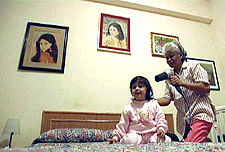A film about the Philippines' second largest export product - maternal…
Working Women of the World

- Description
- Reviews
- Citation
- Cataloging
Focusing on Levi Strauss and Co., WORKING WOMEN OF THE WORLD follows the relocation of garment production from Western countries to nations such as Indonesia, the Philippines, and Turkey, where low wages are the rule and employee rights are nonexistent.
The film introduces us to women like Yanti, a 26-year-old Indonesian who works ten hours a day, six days a week, for $60 a month (the price of a pair of Levi's in Jakarta). Conditions at the factory are dreadful. There are five filthy toilets for 2000 women, and with no ventilation, the factory is an inferno. Any protest is met with immediate intimidation and increased surveillance until the offender quits.
WORKING WOMEN OF THE WORLD also presents the stories of her western counterparts who are losing their jobs. Maria Therese worked in the Levis factory in Yser La Basse, France, and was a union representative there. In interviews, she describes the work, the wage structure, and her negotiations with management and the government after the closure announcement.
Behind the new gospel of free trade are the real lives of women in the North and South. Filmed in Indonesia, the Philippines, Turkey, France, and Belgium, WORKING WOMEN OF THE WORLD puts these women's stories into the larger history and development of globalization.


